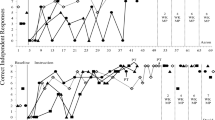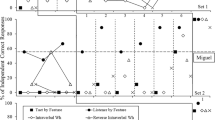Abstract
Repeated nonreinforced preexposure of a stimulus subsequently used as a conditioned or discriminative stimulus typically results in a decrement in performance of infrahumans and humans in classical and instrumental conditioning tasks. The naturalistic or applied significance of this “latent inhibition” phenomenon has not been investigated. This study examined the effects of repeated presentations of verbal commands on the acquisition of instruction-following behavior in two severely retarded girls. Each received 200 preexposures of one command followed by instruction-following training on both the preexposed and a nonpreexposed command. This procedure was repeated for three different pairs of commands for each girl. Commands were given in French and preexposed and nonpreexposed commands were counterbalanced across subjects. Mean percentage of unassisted responses to preexposed commands was 35.9 percentage points less than to nonpreexposed commands on the first day of training. The results suggest that latent inhibition may be a viable phenomenon in applied settings.
Similar content being viewed by others
References
MARKMAN, R., & LUBOW, R.E. Latent inhibition of the pinna response of the albino rabbit as a function of time of delay between pre-exposure and conditioning. Paper presented at the meeting of the Psychonomic Society, Chicago, October 1965.
References
ACKIL, J.E., & MELLGREN, R.L. 1968. Stimulus preexposure and instrumental learning. Psychonomic Science, 11, 339.
CANTOR, G.N. 1969. Stimulus familiarization effect and the change effect in children’s motor task behavior. Psychological Bulletin, 71, 144–160.
CANTOR, G.N., & CANTOR, J.H. 1964. Effects of conditioned-stimulus familiarization on instrumental learning in children. Journal of Experimental Child Psychology, 1, 71–78.
CANTOR, G.N., & CANTOR, J.H. 1966. Discriminative reaction time in children as related to amount of stimulus familiarization. Journal of Experimental Child Psychology, 4, 150–157.
DEHAVEN, E. 1981. Teaching three severely retarded children to follow instructions. Education and Training of the Mentally Retarded, 16, 36–48.
FELDMAN, M.A. 1977. The effects of preexposure to a warning or a safety signal on the acquisition of a two-way avoidance response in rats. Animal Learning and Behavior, 5, 21–24.
GINTON, A., URCA, G., & LUBOW, R.E. 1975. The effects of preexposure to a nonat-tended stimulus on subsequent learning. Bulletin of the Psychonomic Society, 5, 5–8.
HALGREN, C.R. 1974. Latent inhibition in rats: Associative or nonassociative. Journal of Comparative and Physiological Psychology, 86, 74–78.
IVY, R., & DUBIN, W. 1979. Acquisition and generalization of instruction following behavior in profoundly retarded individuals. Perceptual and Motor Skills, 49, 163–169.
KALAT, J.W., & ROZIN, P. 1973. “Learned safety” as a mechanism in long-delay taste aversion learning in rats. Journal of Comparative and Physiological Psychology, 83, 198–207.
KAZDIN, A.E., & ERRICKSON, L.M. 1975. Developing responsiveness to instructions in severely and profoundly retarded residents. Journal of Behavior Therapy and Experimental Psychiatry, 6, 17–21.
LUBOW, R.E. 1973. Latent inhibition. Psychological Bulletin, 79, 398–407.
LUBOW, R.E., ALEK, M., & ARZY, J. 1975. Behavioral decrement following stimulus preexposure: Effects of number of preexposures, presence of a second stimulus and interstimulus interval in children and adults. Journal of Experimental Psychology. Animal Behavior Processes, 1, 178–188.
LUBOW, R.E., & MOORE, A.U. 1959. Latent inhibition: The effect of nonreinforced preexposure to the conditional stimulus. Journal of Comparative and Physiological Psychology, 52, 416–419.
LUBOW, R.E., RIFKIN, B., & ALEK, M. 1976. The context effect: The relationship between stimulus preexposure and environmental preexposure determines subsequent learning. Journal of Experimental Psychology. Animal Behavior Processes, 2, 38–47.
LUBOW, R.E., SCHNUR, P., & RIFKIN, B. 1976. Latent inhibition and conditioned attention theory. Journal of Experimental Psychology. Animal Behavior Processes, 2, 163–174.
MACKINTOSH, N.J. 1973. Stimulus selection: Learning to ignore stimuli that predict no change in reinforcement. In R.A. Hinde & J. Stevenson-Hinde (Eds.). Constraints on learning. London: Academic Press.
PAVLOV, L.P. 1927. Conditioned reflexes. Oxford: Clarendon Press.
SCHNUR, P., & KSIR, C.J. 1969. Latent inhibition in human eyelid conditioning. Journal of Experimental Psychology, 80, 388–389.
SIEGEL, S. 1969a. Effect of Cs habituation on eyelid conditioning. Journal of Comparative and Physiological Psychology, 68, 245–248.
SIEGEL, S. 1969b. Generalization of latent inhibition. Journal of Comparative and Physiological Psychology. 69, 157–159.
SIEGEL, S. 1974. Flavor preexposure and “learned safety”. Journal of Comparative and Physiological Psychology, 87, 1073–1082.
SKINNER, B.F. 1953. Science and human behavior. New York: The Free Press.
STRIEFEL, S., BRYAN, K., & AIKINS, O. 1974. Transfer of stimulus control from motor to verbal stimuli. Journal of Applied Behavior Analysis, 7, 123–135.
STRIEFEL, S., & WHETHERBY, B. 1973. Instruction-following behavior of a retarded child and its controlling stimuli. Journal of Applied Behavior Analysis, 6, 663–670.
WHITMAN, T.L., ZAKARAS, M., & CHARDOS, S. 1971. Effects of reinforcement and guidance procedures on instruction-following behavior of severely retarded children. Journal of Applied Behavior Analysis, 4, 283–290.
Author information
Authors and Affiliations
Additional information
This research was conducted at Southwestern Regional Centre, Blenheim, Ontario and was previously reported at the Association for Behavior Analysis, Annual Convention, Dearborn, Michigan, May 1979. The author thanks C. Burke for her assistance.
Rights and permissions
About this article
Cite this article
Feldman, M.A. The Effect of Command Preexposure on Instruction-Following Behavior in Severely Retarded Adolescents. Psychol Rec 32, 529–535 (1982). https://doi.org/10.1007/BF03394811
Published:
Issue Date:
DOI: https://doi.org/10.1007/BF03394811




